 |
ilp archive : cheltenham 1936
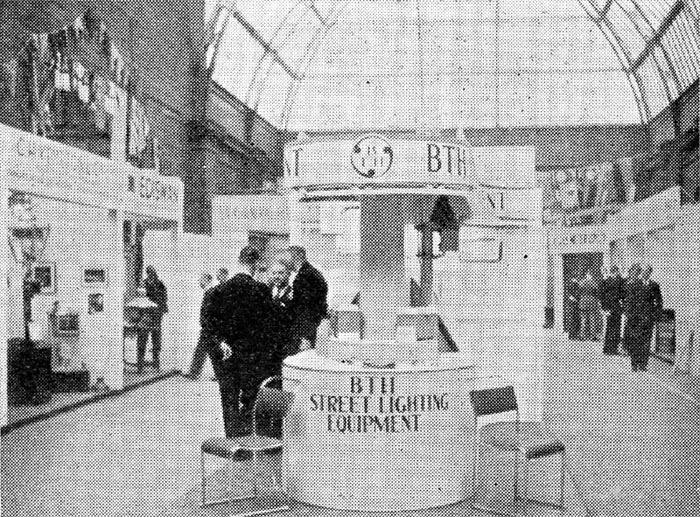
General view of the exhibition
"What makes the Association Conferences somewhat different from
other conferences is that with the A.P.L.E. Conference the town enters into it. It is
not a Conference behind closed doors, the public
are invited to the Exhibition. It is also in the
thoroughfares. The "man in the street" also has a
part in it, the ratepayer, shopkeeper, and the
residents all take part, as was evidenced by the
crowds that thronged the principal thoroughfares
until nearly midnight to view the excellent street
lighting, the flood-lighting of the principal buildings,
churches, flower gardens and fountains, truly, as
one remarked, "a city of light." So eagerly had the
Conference been anticipated that the railway and
coaching companies had made special arrangements
for bringing the people in from the surrounding
towns and taking them home at a late hour. So
great was the crush nightly to view the illuminated
interior of the Parish Church that the doors had to
be closed upon crowds of disappointed sightseers.
On one evening, I am informed, 1,500 passed
through the doors. The municipal season was also
extended one week beyond the usual time, and the
military band retained over that period, whilst the
coach excursions followed suit; in fact, the county
of Gloucester seemed to have entered into the
proceedings."
"It was my privilege to remain in Cheltenham after
the Conference, and the members had departed, and
so great was the interest displayed by the public in
the street lighting and flood-lighting that it was
decided to continue the same over the weekend, and
a Special Service was held in the flood-lighted Parish
Church at 9.30 p.m. on the Sunday following the
Conference."
"I understand from the local Press, published since
the meeting, that the special street lighting is to
remain in operation until the end of the month. It
is understood that the contractors have consented
to this with the purpose of allowing the Cheltenham
Electricity Committee to view the installations with
a view to purchase, following the grant of £500
voted by the Town Council recently."
Captain J. W. Liberty
Public Lighting #3, September 1936
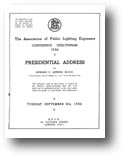
|
Presidential Address
Edward C. Lennox, M.I.E.E.
(North-Eastern Electric Supply Co., Ltd., Newcastle-Upon-Tyne)
Keywords: APLE: Organisation, Lighting: Specifications, Statistics: Accident Data, Lighting: Authority Organisation, Lighting: Theory
Tuesday, September 8th, 1936
Also published in: Public Lighting, Vol. 1, No. 3. September 1936
Abstract: Lennox splits his address into several main sections, each dealing with
one of the varied aspects of the association's work over the previous year.
He
describes changes within the organisation and the publication
of Public Lighting and the Public Lighting Enginner as well as the
forthcoming Education Scheme; the M.O.T. Interim Report is welcomed and
it should obviate any delay on the part of Lighting Authorities waiting the Final Report; Lighing Engineers should use
current press interest and promote new schemes; Road Accident Data (up to 1935) is analysed and
the general conclusion is that if better visibility is provided during dark hours on heavy traffic routes and in built-up areas
then the accident rate would decrease materially; the administraiton
of lighting authorities, car headlights and the clarification of terms.
Road Accident Data
The greatest number of accidents occur:
(a) In winter months - during the hours of 5PM to 8PM
(b) In summer months - during the hours of 10PM to 11PM
Other figures indicate:
(1) The small amount of night traffic as compared with that
during the day. We can assume from the figures quoted that
the proportion of night to day traffic throughout the year does
not exceed 33%.
(2) A large increase in night traffic during the past seven years
of 81%.
Improved lighting lead to a reduction in number and severity of
accidents at night despite 81% increase in traffic.
From the Survey Of Accidents 1933 the following conclusions can be drawn:
(1) Over 46% of the total accidents occuring during the winter months - although traffic
as expressed in vehicle-miles is probably one half of that of summer. As the radio
of accidents winter to summer is approximately 1:1, so the accident rate
winter to summer is approximately 2:1 per vehicle mile, this I believe is
due mainly to increased dark hours during winter months.
(2) Of the accidents which occur during winter months, 52% occur during
dark hours. It is reasonable to suppose that the total vehicles on
the roads during dark hours is only one-third of that during daytime, moreover
the average miles per vehicle during dark hours is probably half that
during daylight, so it is estimated that the figure for vehicle miles
during dark hours is at most one-sixth of that during daylight hours. As
the proportion of accidents dark hours to daylight hours is greater than 1:1,
so the accident risk dark to daylight hours must be said to be greater
than 6:1.
In America, more definite accident data is collected. In Cleveland,
on a certain highway, despite the fact that traffic density at
night is less than half that of day, there were twice as many
fatalities by night as by day - ratio of accident risk night to
day is therefore 4:1. The cost of lighting these main traffic routes
has been estimated to be one-third of the present economic loss
from preventable night accidents. In Detroit it was found that the ratio
of night to day accidents increased from approximately 1:1 to 2:1 when lighting
was curtailed by 35%. "There are approximately 50,000 miles of highway
in the United States on which the night accident rate is at least six times that
of the day accident rate, and on which corresponding saving can be made by the installation
of safety lighting."
"By these and other considerations one is forced to the conclusion that if
better visibility were provided during dark hours on heavy traffic routes and in
built up areas, the accident rate would decrease materially. One feels justified in
believing that the economic gain due to decrease in aciidents would more than
meet the extra expenditure necessary to provide adequate public lighting."
Administration
There are too many Lighting Authorities. Parochial areas have increased average wattage by
30% in the past five years yet it is still not enough. The rateable value for street lighting
is far too small; and in some cases they are paying to light main traffic routes for the
benefits of non-rate payers in that area.
"The benefit [of pooling] is found in an example of a Rural aread which in 1932
adopted Urban powers under Section 161, Public Health Act, 1875, and undertook the
responsibility for lighting in the 13 parishes in the area. Actually the "pooling"
gave extra bargaining power to the Council, and full benefit of this was passed on to
all villages by providing additional lighting points, bigger lamps and increased lighting
hours."
"Until legislation is introduced which will make larger authorities
the Lighting Authority, lighting in these areas [urban, ruran and
parochial] will improve very slowly and certainly not with uniformity."
There are suggestions that the Road Fund should be used to fund lighting.
References:
[1] Public Lighting: Its Necessity and Administration, E. C. Lennox, A.M.I.E.E., Public Works, Roads and Transport Congress (1935).
[2] MOT Interim Report 1935
[3] Ministry Of Transport, Traffic Census, August 1928
[4] Ministry Of Transport, Traffic Census, August 1930
[5] Ministry Of Transport, Traffic Census, August 1935
[6] Survey Of Accidents, 1933
[7] Ministry Of Transport, Report On Fatal Road Accidents (1935), August 1936
|
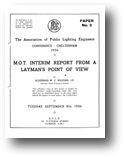
|
MOT Interim Report From A Layman's Point Of View
Alderman W. E. Wilford, J.P.
(Chairman, Watch Committee, Leicester)
Keywords: Lighting: Specifications, Lighting: Authority Organisation
Tuesday, September 8th, 1936
Abstract: Wilford agrees with practically the whole of the conclusions
recommended in the Interim Report but concentrates almost solely on how continuous, uniform and
efficient lighting on main traffic routes can be acheived through a reform of the present
methods of administration.
References:
[1] MOT Interim Report 1935
|
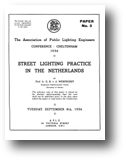
|
Street Lighting Practice In The Netherlands
Professor Ir. G. B. v. d. Werfhorst
(University of Utrecht)
Keywords: Lighting: Authority Organisation, Lighting: Distribution, Lighting: Theory,
Lighting: Luminaires, Lighting: Glare, Lighting: Levels,
Lighting: Lamps,
Lighting: Installations
Tuesday, September 8th, 1936
Abstract: Werfhorst describes the organisation of street lighting in
Belgium and the rapid changes about to happen due to the new thinking about optical design and the number
of new lamp types available.
He notes how "horizontal illumination" or "uniform distribution" theory has been discarded for "good brightness"
and "no dazzle." Example luminaries are illustrated – the "globe-band" and "screened concentrating reflector" - and
their use in two different scenarios are described.
A major portion of the paper is devoted to analysing the effects of contrast under scotopic and photopic
lighting conditions for mercury, sodium and white light. He develops the concept of "apparent brightness" and
"richness in contrast" to support the use of sodium for arterial roads under low lighting conditions.
The theory rests upon the idea that portions of the field-of-view are viewed photopically and others
scotopically at the same time.
The introduction of the new high-pressure mercury lamp is described along with an example installation.
Luminaires: Philips Philulex N.A., Philips Philulex N.D.
References:
[1] Modern Street Lighting, C. C. Paterson, J.I.E. Journal, January 1935.
[2] De Ingenieur, Bouma, BD 290-294, 1934.
[3] Light Und Lampe, Konig, 23, 131, 1934.
[4] Lecture, Dr. Jhr. v. Lennep, Utrecht, February 1936.
[5] The Importance Of Kinematical Factors Of Roadway Illumination, L. J. Davis, M.A., B.Sc.; R. Maxted, B.E. (Elect.), B.E. (Mech.); G. S. Lucas, M.I.E.E., A.P.L.E., 1935
(Note: Originally called Street Lighting Practice In Holland and described as a "short paper." See
Public Lighting #2.)
|
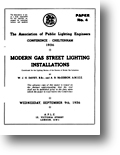
|
Modern Gas Street Lighting Installations
Mr. William J. Gilchrist Davey, B.Sc. (Elm Works Ltd) and A. R. McGibbon, A.M.I.E.E.
Keywords: Lighting: Luminaires, Lighting: Specifications, Lighting: Theory, Lighting: Installations
Wednesday, September 9th, 1936
Also published in: Public Lighting, Vol. 2, No. 5. March 1937
Abstract: "There has been a tendency in past years, especially in papers relating to gas for street lighting,
to describe lighting units rather than installations. It is proposed in this paper to give prominence to installations,
and to demonstrate by means of street lighting schemes, actually in operation or in course of completion, what
can be done in the effective lighting of streets."
"It is hoped to present a plain, unvarnished statement of fact, and to avoid, if possible, any
expression of opinion unpon theoretical questions which may give rise to fruitless controversy, but the description
of street lighting installations should be prefaced by certain conclusions about the broader field of
general street lighting."
The authors discuss their views on the British Standard Specification and the Interim Report by the MOT,
the influence of mounting height on illumination and how the move to 25' is not very adventageous, planning the
district diversity factor and the use of iso-foot-candle diagrams as the preferred method of presenting and studying
installations. They then classifiy various types of gas lantern before presenting 19 modern gas street lighting
installations.
Luminaires: Parkinson Warwick Square,
Sugg Windsor,
Sugg Rochester,
Parkinson Stechford,
Sugg London B/2,
Sugg London C and
Parkinson Maxill.
References:
[1] The Planning of Gas Installations to Conform with the British Standard Specification for Street Lighting, F. C. Smith, A.P.L.E., 1932
[2] Retention of Gas for Public Lighting, Davey, Gas Times, 3/9/1935
[3] An Analysis of Modern Views on Street Lighting and their Relation to Visibility, F. C. Smith and K. F. Sawyer, A.P.L.E., 1935
[4] Photographic Representation of Street Lighting Installations, Vol I., No. 2, Trans I.E.S.
[5] MOT Interim Report 1935
(Note: This paper replaced Gas Street Lighting Units which was to be given by
Mr. Philip Sugg. See Public Lighting #2.)
|
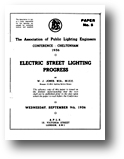
|
Electric Street Lighting Progress
W. J. Jones, M.Sc., M.I.E.E.
(Manager, E.L.M.A. Lighting Service Bureau)
Keywords: Lighting: Installations, Lighting: Lamps, Lighting: Levels, Statistics: Road Data
Wednesday, September 9th, 1936
Abstract: "With the greater availability of electricity supply and the vast improvements in the efficiency of electric light sources, it is evident
that phenomenal extensions in electric street lighting have been made during recent years. The public gain by obtaining an improved standard of street lighting,
with due regard to the economies affecting public expenditure."
Jones sums up the progress of electric street lighting by summarising the events of the last 25 years. He singles out increased mounting heights,
the increase of road traffic and electric lighting costs, improvements in electric lamps (from carbon through to electric discharge), the group replacement of
lamps, improvements in electric discharge lighting, the classification of road types, examples of modern installations and finally the situation in Europe.
References:
[1] The High-Pressure Mercury Vapour Lamp in Public Lighting, G. H. Wilson, B.Sc. (Eng), E. L. Damant, Lieut.-Commander R.N. (Retd), Associate Member, J. M. Waldram, B.Sc. (Eng), I.E.E., 4th February 1936
[2] The Physical Characteristics of Electric Discharge Lamps, L. J. Davies, M.A., B.Sc., ???, ???
[3] Some further Aspects in Gases and Vapours of Electric Discharge, J. N. Aldington, Engineering Supplement to the Siemens Magazine, No. 131, April 1936.
[4] Electric Discharge Lamps, William Rule, M.Sc., F.Inst.P, ???, December 1935.
(Note: Originally called Progress In Electric Street Lighting. See
Public Lighting #2.)
H. W. Gregory, M.I.E.E continued the discussion in
Public Lighting #3.
|
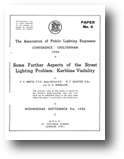
|
Further Aspects of the Street Lighting Problem: Kerbline Visibility
F. C. Smith, F.C.S., Assoc. M.Inst.G.E., K. F. Sawyer, B.Sc. and D. G. Winslow
Keywords: Lighting: Distribution, Lighting: Installations, Lighting: Theory
Wednesday, September 9th, 1936
Abstract: "Much has been said and written from time to time about the lighting requirements of
the rodaway and how these may be met in practice; but little attention, so far as the authors are aware,
has been given to ensuring that the margins of the roadway are suitably and clearly defined. In
this paper an account is given of some preliminary work on the investigation of this problem
both from the theoretical and practical aspects."
(Note: This paper replaced a short paper called Some Further Aspects Of The Street Lighting
Problem which was to be given by
Mr. C. A. Masterman. See Public Lighting #2.)
|
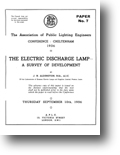
|
The Electric Discharge Lamp - A Survey Of Development
J. N. Aldington, B.Sc., A.I.C.
(Of the Laboratories of Siemens Electric Lamps and Supplies, Limited, Preston, Lancs.)
Keywords: Lighting: Lamps
Thursday, September 10th, 1936
Also published in: Public Lighting, Vol. 1, No. 4. December 1936
Abstract: Aldington summarises the current research into the mercury discharge lamp. He firstly discusses the
current range of lamps (150W, 250W and 400W) before describing current research: colour modulated
high pressure discharge lamps (by additives to the mercury), the development of the Dual Lamp,
the improvement of the mercury discharge by using quartz discharge tubes, air cooled quartz discharge
tubes (including a 100W experimental lamp), the effect of pressure on the mercury discharge lamp,
colour modulation by means of fluorescent substances, combinations of quartz lamps and incandescent lamps,
and super high pressure mercury lamps. This paper provides the groundwork for many of the commerical
lamps which would appear the following year.
References:
[1] Electric Discharge Lamps and their Application to Public Lighting, G. H. Wilson, B.Sc. (Eng), A.P.L.E., September 1933
[2] Electric Discharge Lamps. J. W. Ryde Journal of the Royal Society of Arts. Vol. 82.
[3] Electric Discharge Lamps and their Application to Road Lighting, L. J. Davis and H. Warren, Institution of Automobile Engineers, February 1936
[4] The High-Pressure Mercury Vapour Lamp in Public Lighting, G. H. Wilson, B.Sc. (Eng), E. L. Damant, Lieut.-Commander R.N. (Retd), Associate Member, J. M. Waldram, B.Sc. (Eng), I.E.E., 4th February 1936
[5] Some Recent Developments in the Electric Lamp, J. N. Aldington, Association of Engineers, Belfast, 5th February 1936.
[6] Some Further Aspects of the Electrical Discharge in Gases and Vapours, J. N. Aldington, Engineering Supplement to the Siemens Magazine, No. 131, April 1936.
(Note: This paper replaced Recent Developments Of The Electric Discharge Lamps
which was to be given by Mr. C. Hughes. See Public Lighting #2.)
|
|



